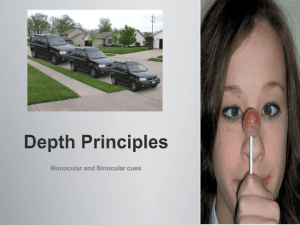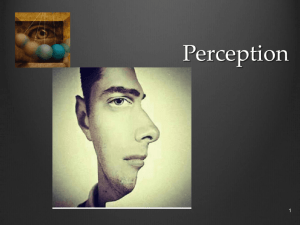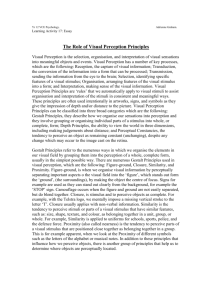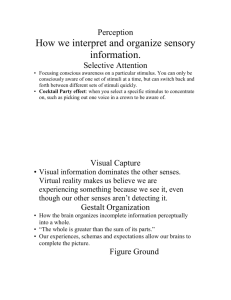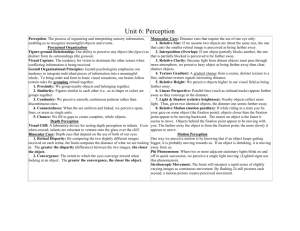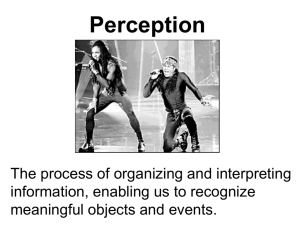Mikayla's Visual perception principles PowerPoint
advertisement
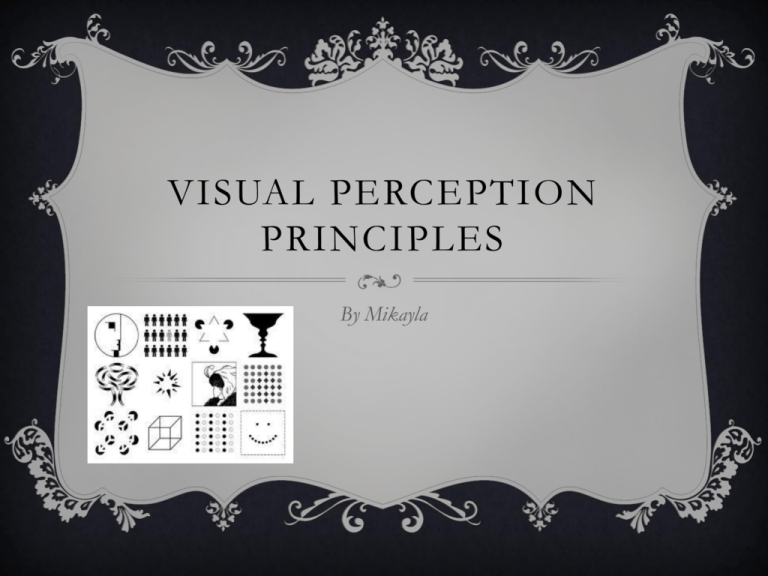
VISUAL PERCEPTION PRINCIPLES By Mikayla VISUAL PERCEPTION PRINCIPLES Gestalt principles Depth principles 1. Closure *Binocular 2. Proximity 1) Convergence 3. Similarity 2) Retinal disparity 4. Figure-ground *Monocular 1) Accommodation 2) Pictorial cues 1) Linear perspective 2) Interposition 3) Texture gradient 4) Relative size 5) Height in visual field VISUAL PERCEPTION PRINCIPLES Are rules that we apply to visual information to assist our organisation and interpretation of the information in consistent and meaningful ways. GESTALT PRINCIPLES Refer to the ways in which we organise the features of a visual scene by grouping them to perceive a whole, complete form. FIGURE-GROUND ORGANISATION. When we use figure-ground, we organise visual information by perceptually dividing a visual scene into a ‘figure’, which stands out from the ‘ground’, which is it’s surroundings. Figure ground organisation is generally achieved when we separate the figure from the ground using a line or boundary between the figure and the ground, which may or may not exist in the scene. This line of separation between the figure and ground is known as a contour. CLOSURE Closure refers to the perceptual tendency to mentally ‘close up’, fill in or ignore gaps in a visual image and to perceive object as complete (‘whole’). PROXIMITY The principle of proximity (or nearness) is the tendency to perceive parts of a visual images which are positioned close together as belonging together in a group. SIMILARITY Involves the tendency to perceive parts of a visual image that have similar features- such as size shape texture or colour. DEPTH PRINCIPLES Depth perception is the ability to accurately estimate the distance of objects and therefore perceive the world in three dimensions. DEPTH CUES Sources of information from the environment (external cues) of from within our body (internal cues) that help us to peceive how far away objects are and therefore to perceive depth. Depth cues can be categorised into two groups- binocular (requiring the use of both eyes) or monocular (requiring the use of only one eye). BINOCULAR DEPTH CUES Require the use of both eyes working together in order to provide information to the brain about depth and distance. CONVERGENCE Involves the brain detecting and interpreting depth or distance from changes in tension in the eye muscles that occur when the two eyes turn inwards to focus on objects that are close. RETINAL DISPARITY Refers to the very slight difference (‘disparity’) in the location of the visual images on the retinae (due to their slightly different angles of views) which enables us to make judgements about the depth or distance of an object. MONOCULAR DEPTH CUES Require the use of only one eye to provide information to the brain about depth and distance, but they also operate with both eyes. They include accommodation and pictorial cues such as linear perspective, interposition, texture gradient, relative size and height in the visual field. ACCOMMODATION Involves the automatic adjustment of the shape of the lens to focus an object in response to changes in how far away the object is. PICTOIRAL CUES Pictorial cues are so named because artists use them to create depth and distance on two dimensional surfaces such as paper and canvas. LINEAR PERSPECTIVE Is the apparent convergence of parallel lines as they recede (‘go back’) into the distance. INTERPOSITION Or overlap as it is also called, occurs when one object partially blocks or covers another, and the partially blocked object is perceived as further away than the object that obscures it (and vice versa). TEXTURE GRADIENT Refers to the gradual reduction of detail that occurs in as surface as it recedes into the distance, compared with a surface that is close and perceived in fine detail. RELATIVE SIZE Refers to the tendency to visually perceive the object that produces the largest image on the retina as being closer, and the object that produces the smallest image on the retina as being further away. HEIGHT IN THE VISUAL FIELD Refers to the location of objects in our field of vision, whereby objects that are located closer to the horizon are perceived as being more distant than objects located further from the horizon. PERCEPTUAL CONSTANCIES Refers to the tendency to perceive an object as remaining stable and unchanging (constant) despite any changes that may occur to the image on the retina. SIZE CONSTANCY Involves recognising that an object’s actual size remains the same even though the size of the image it casts on each retina changes. SHAPE CONSTANCY Is the tendency to perceive an object as maintaining its shape despite any change in the shape of the image of the object on the retina. BRIGHTNESS CONSTANCY Is the tendency to perceive an object as maintaining its level of brightness in relation to its surroundings, despite changes in the amount of light being reflected from the object to the retina. PERCEPTUAL SET Is the predisposition, or readiness’, to perceive something in accordance with what we expect it to be. CONTEXT In visual perception refers to setting or environment in which perception is made. MOTIVATION Refers to processes within us which activate behaviour that is directed towards achieving a particular goal. EMOTIONAL STATE How we are feeling, can also influence the way in which we perceive visual information. Different emotions can ‘set’ us to perceive information in a particular way which is consistent with the emotion being experienced. PAST EXPERIENCE refers to our personal experiences throughout our lives. This includes everything we learn through experience, both intentionally and unintentionally. Our unique combination of past experiences can lead us to many differences in perception. Such experiences also predispose, or ‘set’ us to perceive information in a particualr way. CULTURAL FACTORS Refers to the way of life of a particular community or group that sets it apart from other communities and groups. Culture includes such things as the customs, traditions, beliefs, values, attitudes, rules about what is right and wrong, music and food, as well as any other features of that community or group which distinguish it from other communities or groups. Experience with or in a particular culture can influence the way we process and interpret visual information.
